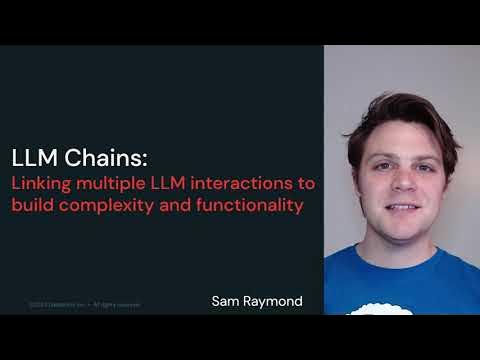Boost AI Performance with an Ensemble of AI Models
Summary
TLDRThis video highlights the power of combining traditional AI and large language models (LLMs) in a dynamic, multi-model framework to enhance business applications. By leveraging the strengths of each model type—speed, accuracy, energy efficiency, and adaptability—businesses can make more informed decisions. Through examples like fraud detection in finance and insurance claim analysis, the video demonstrates how a hybrid approach allows for real-time, accurate predictions while optimizing performance. This versatile technique empowers companies to maximize the value of their growing AI toolbox, offering flexibility in choosing the right model for the right situation.
Takeaways
- 😀 AI is increasingly being used across businesses, with constant innovations adding new models and techniques.
- 😀 The 'AI toolbox' concept highlights the importance of dynamically using different models based on the situation to get maximum value.
- 😀 Traditional AI models are fast, energy-efficient, and excel at working with structured data for tasks like fraud detection and medical analysis.
- 😀 Large Language Models (LLMs) are more accurate, but they are slower, less energy-efficient, and work well with both structured and unstructured data.
- 😀 The hybrid model approach leverages multiple AI models to combine the strengths of each, improving overall efficiency and outcomes.
- 😀 Traditional AI models use structured data and rules to make predictions with confidence ratings in industries like finance and healthcare.
- 😀 Encoder models in LLMs start with structured data and tend to have higher accuracy, but they come with trade-offs in power and latency.
- 😀 Decoder models, another type of LLM, generate new data from unstructured inputs, like chatbots and creative text generation.
- 😀 In dynamic AI environments, models can be switched based on the situation, balancing accuracy, speed, and resource efficiency.
- 😀 In financial fraud analysis, traditional AI models provide quick, confident predictions, while LLMs can be used when higher accuracy is needed in cases of lower confidence.
- 😀 In insurance claim analysis, both structured and unstructured data are processed, with traditional AI models handling structured data and LLMs handling unstructured data to enhance predictions.
Q & A
What is the main focus of the video script?
-The main focus of the video is the dynamic and flexible use of a combination of AI models, emphasizing how leveraging different strengths of traditional AI and large language models (LLMs) can optimize business processes.
What are the primary tools discussed in the video?
-The primary tools discussed are traditional AI (machine learning and deep learning models), large language models (LLMs), encoder models, and decoder models.
How do traditional AI models work, and where are they commonly applied?
-Traditional AI models work with structured data by following a set of rules to make predictions, along with a confidence rating. They are commonly applied in fields such as fraud analysis, anti-money laundering, insurance claim analysis, and medical image analysis.
What are the key strengths of traditional AI models?
-Traditional AI models are smaller in size, have lower latency (faster processing), and are more energy-efficient, making them ideal for real-time applications where speed and efficiency are critical.
What distinguishes encoder models from traditional AI models?
-Encoder models can handle both structured and unstructured data. They provide higher accuracy than traditional AI models but come with the trade-off of higher power usage and higher latency.
What are decoder models, and how are they different from encoder models?
-Decoder models start with unstructured data and generate new data, such as chatbots or content generation. Unlike encoder models, which process and analyze data, decoder models focus on creating new data based on input.
What is the benefit of using a hybrid approach of multiple AI models?
-A hybrid approach allows businesses to dynamically switch between different models based on their needs, optimizing for accuracy, speed, and energy efficiency based on the specific situation.
Can you provide an example of how hybrid AI models are used in fraud detection?
-In fraud detection, a traditional AI model can quickly analyze a credit card transaction in real-time for potential fraud. If the confidence in the prediction is low, the system can switch to a larger, more accurate model (LLM) to ensure a higher degree of certainty, balancing both speed and accuracy.
How does the hybrid model approach work in insurance claim analysis?
-In insurance claim analysis, an LLM can first process unstructured data (like text describing the incident) and convert it into structured data. Then, a traditional AI model can be used for quick predictions. If needed, a larger model can be applied to refine the accuracy of the analysis.
What are the trade-offs when using larger models like LLMs compared to traditional AI models?
-Larger models like LLMs are generally more accurate but come with higher power consumption, slower processing times (higher latency), and less energy efficiency. In contrast, traditional AI models are faster, smaller, and more energy-efficient but may not provide the same level of accuracy.
Outlines

This section is available to paid users only. Please upgrade to access this part.
Upgrade NowMindmap

This section is available to paid users only. Please upgrade to access this part.
Upgrade NowKeywords

This section is available to paid users only. Please upgrade to access this part.
Upgrade NowHighlights

This section is available to paid users only. Please upgrade to access this part.
Upgrade NowTranscripts

This section is available to paid users only. Please upgrade to access this part.
Upgrade NowBrowse More Related Video
5.0 / 5 (0 votes)





